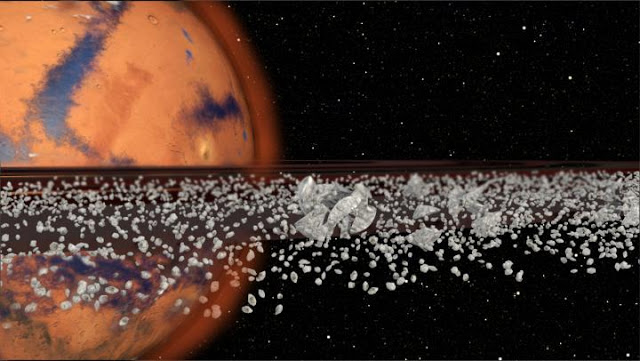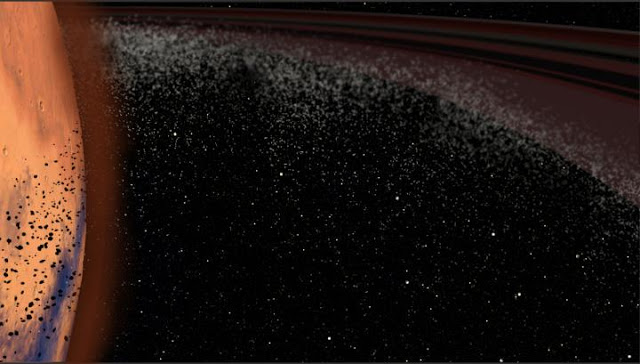

| Online: | |
| Visits: | |
| Stories: |

| Story Views | |
| Now: | |
| Last Hour: | |
| Last 24 Hours: | |
| Total: | |
Mars May One Day Have Rings Like Saturn
That’s the theory put forth by Purdue University scientists, whose findings were published in the journal Nature Geoscience. David Minton, assistant professor of Earth, atmospheric and planetary sciences, and Andrew Hesselbrock, a doctoral student in physics and astronomy, developed a model that suggests that debris that was pushed into space from an asteroid or other body slamming into Mars around 4.3 billion years ago and alternates between becoming a planetary ring and clumping up to form a moon.
A theory exists that Mars’ large North Polar Basin or Borealis Basin, which covers about 40 percent of the planet in its northern hemisphere, was created by that impact, sending debris into space.
Phobos, a Martian moon, might eventually disintegrate and form a ring around the red planet, according to a new theory by Purdue University scientists. The NASA-funded research indicates that this process of moons breaking apart into rings and then reforming as moons may have happened several times over billions of years.

Image by Purdue University Envision Center
“That large impact would have blasted enough material off the surface of Mars to form a ring,” Hesselbrock said. Hesselbrock and Minton’s model suggests that as the ring formed and the debris slowly moved away from the planet and spread out, it began to clump and eventually formed a moon. Over time, Mars’ gravitational pull would have pulled that moon toward the planet until it reached the Roche limit, the distance within which the planet’s tidal forces will break apart a celestial body that is held together only by gravity.
A new theory by Purdue University scientists says that the Martian moon Phobos might eventually break apart, forming a ring around the red planet. The NASA-funded scientists theorize that this ring formation has happened before, and that as the moons break apart some of the material falls to the surface, as shown in this illustration.

Illustration by Purdue University Envision Center
“You could have had kilometer-thick piles of moon sediment raining down on Mars in the early parts of the planet’s history, and there are enigmatic sedimentary deposits on Mars with no explanation as to how they got there,” Minton said. “And now it’s possible to study that material.”
“Not much has happened to Deimos’ orbit since it formed,” Minton said. “Phobos passing through these resonances would have changed that.”
Richard Zurek of NASA’s Jet Propulsion Laboratory, Pasadena, California, is the project scientist for NASA’s Mars Reconnaissance Orbiter, whose gravity mapping provided support for the hypothesis that the northern lowlands were formed by a massive impact.
“This research highlights even more ways that major impacts can affect a planetary body,” he said.
Minton and Hesselbrock will now focus their work on either the dynamics of the first set of rings that formed or the materials that have rained down on Mars from disintegration of moons.
Steve Tally
Purdue University
Source: http://www.ineffableisland.com/2017/03/mars-may-one-day-have-rings-like-saturn.html


